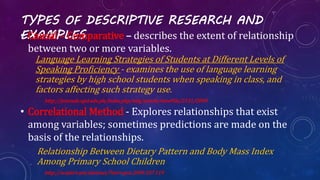Descriptive research and Correlational Research
- 1. PART 1 DESCRIPTIVE RESEARCH WHO, WHAT, WHERE, WHEN, HOW AND HOW MANY
- 2. THE DESCRIPTIVE RESEARCH describes what exists and may help to uncover new facts and meaning. This approach is used to describe variables rather than to test a predicted relationship between variables. Polit D.F., Hungler B.P. (1999) Nursing Research: Principles and Methods (6th Ed.) Philadelphia, Lippincott Set to seek out accurate information and adequate descriptions of activities, objects, processes and persons. Allison, B., Race P. (2004) The StudentsŌĆÖ Guide to Dissertation Preparation and Theses. (2nd Ed.) RoutledgeFalmer. London devoted to the gathering of information about prevailing conditions or situations for the purpose of description and interpretation. Dr. Y.P. Aggarwal (2008). Statistics of Education. (2nd Ed.) Sterling . Delhi.
- 3. NATURE OF DESCRIPTIVE RESEARCH ŌĆó It is the best methods for collecting information to demonstrate relationships and describe the world as it exists and are often done before an experiment to know what specific things to manipulate and include in an experiment Bickman, L., & Rog, D.J. (1998). Handbook of Applied Social Research Methods. Newbury Park, CA. ŌĆó because it can answer ŌĆ£what isŌĆØ and ŌĆ£what wasŌĆØ the nature of a situation as it exists at the time of the study and to explore the causes of particular phenomena through the collection of census data.Travers R. (1978) Introduction to Educational Research. (4th ed.). McMillan. London ŌĆó useful when it is impossible to test and measure the large population which is the subject of quantitative types of experimentation.
- 4. NATURE OF DESCRIPTIVE RESEARCH ŌĆó descriptive research may be more analytic. It often focuses on a particular variable or factor. ŌĆó low on the "control or manipulation of research context" scale. It is non-intrusive and deals with naturally occurring phenomena. http://linguistics.byu.edu/faculty/henrichsenl/ResearchMethods/RM_2_05.html ŌĆó The answer in a descriptive research can no way be definitive. https://explorable.com/descriptive-research-design
- 5. AIMS OF A DESCRIPTIVE RESEARCH ŌĆó provides a knowledge base which can be a springboard for other types of quantitative research methods because it maps the terrain of a specific phenomenon. ŌĆó contribute in the formation of principles and generalization in behavioral sciences contribute in the establishment of standard norms of conduct, behavior, or performance. reveal problems or abnormal conditions ; and if correctly interpreted, the data gathered can provide useful insight which may lead to hypothesis ŌĆō formation. Travers R. (1978) Introduction to Educational Research. (4th ed.). McMillan. London
- 6. TYPES OF DESCRIPTIVE RESEARCH AND EXAMPLESŌĆó Observational Method - animal and human behavior is closely observed which can be in a natural environment or in a laboratory Is Food Intake Associated with Pre-Adolescent Obesity? An Observational Study in Metro Manila, Philippines.* ŌĆó Case Study Method - involves an in-depth study of an individual or group of individuals and is often leads to testable hypotheses which allows for a study of a rare phenomena. Water Pollution Control - A Guide to the Use of Water Quality Management Principles: A Case Study of the Pasig River** Jackson, S.L. (2009). Research Methods and Statistics: A Critical Thinking Approach 3rd edition. Belmont, CA: Wadsworth. *http://scialert.net/abstract/?doi=ajcn.2009.107.119 **http://www.who.int/water_sanitation_health/resourcesquality/wpccasestudy3.pdf
- 7. TYPES OF DESCRIPTIVE RESEARCH AND EXAMPLESŌĆó Causal ŌĆō Comparative ŌĆō describes the extent of relationship between two or more variables. Language Learning Strategies of Students at Different Levels of Speaking Proficiency - examines the use of language learning strategies by high school students when speaking in class, and factors affecting such strategy use. http://journals.upd.edu.ph/index.php/edq/article/viewFile/2131/2049 ŌĆó Correlational Method - Explores relationships that exist among variables; sometimes predictions are made on the basis of the relationships. Relationship Between Dietary Pattern and Body Mass Index Among Primary School Children http://scialert.net/abstract/?doi=ajcn.2009.107.119
- 8. TYPES OF DESCRIPTIVE RESEARCH AND EXAMPLESŌĆó Developmental Studies - the systematic study of designing, developing, and evaluating instructional programs, processes Terman Study of the Gifted ŌĆō began in 1921 and is still running today Wikipedia.com ŌĆó Survey Method - participants answer questions administered through interviews or questionnaires. After participants answer the questions, researchers describe the responses given. A Survey on the FilipinoŌĆÖs Acceptance of the K to 12 curriculum, SWS June 2011 ŌĆō March 2012. Official Gazette . http://www.gov.ph/
- 9. ADVANTAGES OF DESCRIPTIVE RESEARCH ŌĆó gives researchers the opportunity to use both quantitative and qualitative data in order to find data and characteristics about the population or phenomenon that is being studied, ŌĆó The data collection for descriptive research presents a number of advantages as it can provide a very multifaceted approach. Data can include case studies, observation or surveys and give several angles on the information. http://science.blurtit.com/316422/what-are-some-advantages-and-disadvantages-of-descriptive-research
- 10. DISADVANTAGES OF DESCRIPTIVE RESEARCHŌĆó Confidentiality - Confidentiality is the primary weakness of descriptive research. Often subjects are not truthful as they feel the need to tell the researcher what they think the researcher wants to hear. ŌĆó Objectivity and error - Descriptive research also presents the possibility for error and subjectivity. For example, when a researcher designs a questionnaire, questions are predetermined and prescriptive. Furthermore, the study may contain errors, as the researcher may record what she wants to hear and ignore data that does not conform to the research project's hypothesis. http://science.blurtit.com/316422/what-are-some-advantages-and-disadvantages-of-descriptive-research
- 11. CONDUCTING A DESCRIPTIVE RESEARCH Step One: Define a Problem to Research Step Two: Write a Research Question and Sub-questions Step Three: Design and Develop a Survey/Questionnaire Step Four: Create a Cover Letter Step Five: Select a Sample Step Six: Pilot the Survey Step Seven: Administer the Survey Step Eight: Analyze Data https://www.aea267.k12.ia.us/system/assets/uploads/files/1470/descriptiveresearch.pdf
- 12. PART 2 CORRELATIONAL RESEARCH WHAT, WHY AND WHAT IF
- 13. NATURE OF CORRELATIONAL RESEARCH ŌĆó Sometimes called ŌĆ£associational researchŌĆØ ŌĆó It is a more complicated from of descriptive research ŌĆó Collects data and investigates to what degree is the relationship between two or more quantifiable variables without any attempt of manipulation. ŌĆó The relationship between variables are can be describe using the correlation coefficient (the most common of which is the Pearson Product Moment of Correlation Coefficient).* http://www.unm.edu/~marley/methppt/fall07/ppt/day10.pdf *http://stattrek.com/statistics/correlation.aspx
- 14. AIMS OF CORRELATIONAL RESEARCH ŌĆó Used to either explore ŌĆ£the extents to which two or more variables co-vary, that is, where changes in one variable are reflected in changes in the otherŌĆØ ŌĆó when purpose of the study is to predict certain outcomes in one variable from another variable that serves as the predictor. Creswell, J. (2008). Educational Research: Planning, Conducting, and Evaluating Quantitative and Qualitative Research. New Jersey: Pearson: Merrill Prentice Hall.
- 15. TYPES OF CORRELATIONAL RESEARCH ŌĆó Used to either explore ŌĆ£the extents to which two or more variables co-vary, that is, where changes in one variable are reflected in changes in the otherŌĆØ ŌĆó when purpose of the study is to predict certain outcomes in one variable from another variable that serves as the predictor. Creswell, J. (2008). Educational Research: Planning, Conducting, and Evaluating Quantitative and Qualitative Research. New Jersey: Pearson: Merrill Prentice Hall.
- 16. TYPES OF VARIABLES (PREDICTION DESIGN) ŌĆó PREDICTOR VARIABLE ŌĆō used to make a forecast or prediction ŌĆó CRITERION VARIABLE : the anticipated outcome that is being predicted ŌĆó Predicting Satisfaction in Physical Education Classes: A Study Based on Self-Determination Theory* ŌĆó Predicting Success for Virtual School Students: Putting Research-based Models into Practice** Creswell, J. (2008). Educational Research: Planning, Conducting, and Evaluating Quantitative and Qualitative Research. New Jersey: Pearson: Merrill Prentice Hall. *http://benthamscience.com/ **http://www.westga.edu/~distance/ojdla/winter114/roblyer114.html
- 17. TYPES OF VARIABLES (PREDICTION DESIGN) ŌĆó PREDICTOR VARIABLE ŌĆō used to make a forecast or prediction ŌĆó CRITERION VARIABLE : the anticipated outcome that is being predicted ŌĆó Predicting Satisfaction in Physical Education Classes: A Study Based on Self-Determination Theory* ŌĆó Predicting Success for Virtual School Students: Putting Research-based Models into Practice** Creswell, J. (2008). Educational Research: Planning, Conducting, and Evaluating Quantitative and Qualitative Research. New Jersey: Pearson: Merrill Prentice Hall. *http://benthamscience.com/ **http://www.westga.edu/~distance/ojdla/winter114/roblyer114.html
- 18. STEPS IN CORRELATIONAL STUDIES ŌĆó Step One: Selection of the problem ŌĆó Step Two: Selection of the sample and the tools ŌĆó Step Three: Design and procedure ŌĆó Step Four: Interpretation of the Findings Creswell, J. (2008). Educational Research: Planning, Conducting, and Evaluating Quantitative and Qualitative Research. New Jersey: Pearson: Merrill Prentice Hall.
- 19. OTHER SOURCES: ŌĆó http://psych.csufresno.edu/psy144/Content/Design/Nonexperimental/observation.html ŌĆó http://webcache.googleusercontent.com/search?q=cache:http://www.mu.ac.in/myweb_test/Rese arch%2520Methadology-Paper-3/Chapter-5.pdf ŌĆó http://ori.hhs.gov/education/products/sdsu/res_des1.htm ŌĆó https://www.aea267.k12.ia.us/system/assets/uploads/files/1470/descriptiveresearch.pdf



















